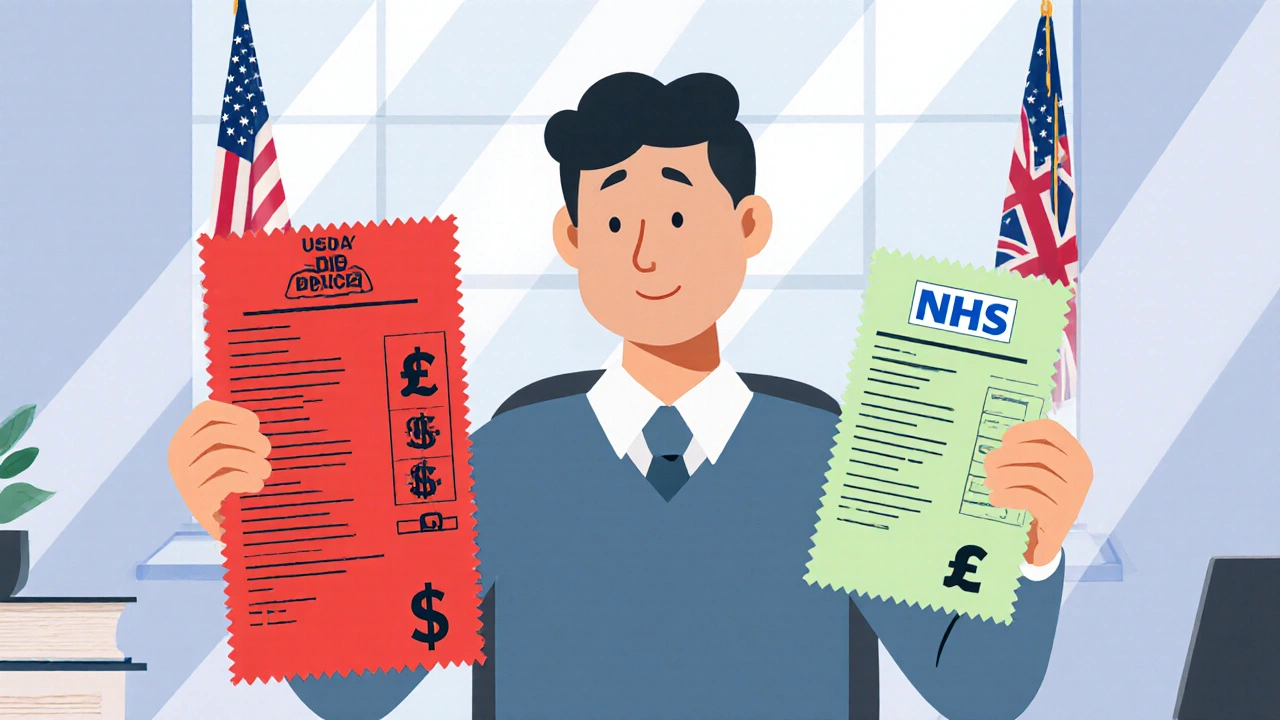 Oct, 18 2025
Oct, 18 2025
Healthcare Cost Comparison Calculator
Healthcare Cost Comparison Calculator
Key insight: Based on article data, US healthcare costs are approximately 4.09x higher than UK costs for routine medical services (e.g., $45 vs. £8 for a primary-care visit).
When you hear the phrase healthcare costs, you probably picture a hefty medical bill. But how do those bills stack up across the Atlantic? In this article we break down the biggest price drivers in the United States and the United Kingdom, compare real‑world data, and give you a clear picture of which system really burns a hole in a patient’s pocket.
TL;DR - Quick Takeaways
- The US spends roughly 2.5 times more per capita on healthcare than the UK.
- Average out‑of‑pocket expenses for a routine primary‑care visit are about $45 in the US versus £8 (≈$11) in the UK.
- Prescription drugs cost almost six times more in the US on average.
- Hospital stays in the US can be 3‑4× higher for the same procedure.
- Insurance coverage models differ dramatically: the US relies on private insurers and government programs, while the UK’s NHS provides universal coverage.
Understanding the Two Systems
United States healthcare costs are driven by a mix of private insurance, Medicare, Medicaid, and a growing number of high‑deductible health plans. The system is market‑based, meaning providers set prices and insurers negotiate contracts, often leading to wide price variation across states and even between hospitals in the same city.
United Kingdom healthcare costs are largely controlled by the National Health Service (NHS), a publicly funded system that provides free care at the point of use for residents. Funding comes from general taxation, and the government sets tariffs for services, which keeps prices relatively uniform nationwide.
These structural differences set the stage for the cost gap you’ll see in the data below.
Key Cost Drivers in Both Countries
To compare apples to apples, we need to look at the same categories of spending:
- Primary‑care visits
- Hospital inpatient stays
- Prescription drugs
- Emergency department (ED) visits
- Out‑of‑pocket expenses for the average household
Each of these categories reflects a combination of provider pricing, insurance reimbursement rates, and patient cost‑sharing mechanisms.
Data Snapshot - 2024 Figures
| Category | United States (Average) | United Kingdom (Average) | Cost Ratio (US/UK) |
|---|---|---|---|
| Primary‑care visit | $115 (including co‑pay) | £8 (~$11) | ≈10.5× |
| Hospital stay (per night) | $2,300 | £450 (~$620) | ≈3.7× |
| Prescription drug (30‑day supply) | $115 | $20 (NHS subsidized) | ≈5.8× |
| Emergency department visit | $1,560 | £190 (~$260) | ≈6.0× |
| Annual out‑of‑pocket per household | $5,300 | $500 | ≈10.6× |
All figures are sourced from the OECD Health Statistics 2024, the Centers for Medicare & Medicaid Services (CMS) reports, and the UK’s NHS Digital cost‑analysis publications. Currency conversion uses the 2024 average rate of 1 GBP = 1.38 USD.
Why the US Pays More
Three main forces push US prices up:
- Negotiated pricing. Unlike the NHS, US insurers negotiate with each provider individually, and many hospitals charge higher list prices to hedge against lower reimbursement rates.
- Administrative overhead. The fragmented system requires separate billing, claims processing, and prior‑authorization steps, adding roughly 15‑30% to total costs.
- Technology and drug pricing. The US market encourages rapid adoption of new technologies and grants patents that keep drug prices high for years.
For instance, a knee replacement in a top US hospital averages $45,000, while the same procedure in an NHS trust is around $13,000, largely because the NHS caps the tariff and negotiates bulk discounts for implants.

Why the UK Keeps Spending Low
The NHS’s centralized bargaining power lets it secure lower prices for drugs and equipment. Additionally:
- Price caps. The government sets national tariffs for surgeries and inpatient stays, limiting how much a hospital can charge.
- Universal coverage. With no need for private insurers, administrative costs are dramatically lower-about 5% of total health spending versus 25% in the US.
- Preventive focus. Public health campaigns and free primary‑care visits reduce the need for expensive emergency care.
However, the UK does face hidden costs: longer waiting times for elective procedures and occasional out‑of‑pocket payments for prescriptions (though many are subsidized).
Breakdown of Insurance Structures
Understanding insurance helps explain the out‑of‑pocket gap.
United States: Most people obtain coverage through employer‑sponsored plans or the ACA marketplace. Typical plans feature a deductible ranging from $1,500 to $5,000, after which co‑pays apply. Medicare (for those 65+) and Medicaid (for low‑income) provide safety nets, but even beneficiaries often face significant copays for specialty drugs.
United Kingdom: The NHS covers almost all services. Residents may pay a modest prescription charge of £9.35 per item (about $13), but many qualify for exemptions. Private health insurance exists for faster access to specialists, but it covers a small fraction of the population and is supplemental.
Special Cases: Cancer Treatment and Rare Diseases
Cancer care highlights the cost divergence. A 12‑month chemotherapy regimen for breast cancer averages $120,000 in the US, while the NHS charges roughly $27,000, thanks to negotiated drug prices and the use of generic alternatives where possible. For rare diseases, both countries rely on special funding pathways, but the US still typically pays higher per‑patient costs.
What the Numbers Mean for Consumers
If you’re an expat or planning a medical trip, these figures can guide your decisions:
- Travel for elective surgery. Some US patients travel to the UK for procedures like hip replacements to save up to 70%.
- Prescription budgeting. US residents on chronic meds should explore Medicare Part D or high‑deductible health plans that lower upfront costs.
- Emergency preparedness. In the US, a single ER visit can exceed $2,000; having a high‑deductible plan with a health savings account (HSA) can soften the blow.

Looking Ahead - Trends Through 2025
Both countries are grappling with rising demand and inflation:
- In the US, value‑based care models and price transparency rules (CMS initiatives) aim to curb overpricing, but adoption is uneven.
- The UK plans to increase NHS funding by 4% annually, yet staff shortages may push some services toward private providers, adding a new cost layer for patients who opt‑out.
Technology will also play a role. Telemedicine costs have fallen dramatically, with virtual visits averaging $25 in the US and being free under the NHS’s digital services.
Checklist - How to Manage Your Healthcare Expenses
- Know your insurance details - deductible, out‑of‑pocket max, and covered services.
- Use price‑comparison tools (e.g., Healthcare Bluebook in the US, NHS Choices cost estimator in the UK) before major procedures.
- Ask providers for itemized bills; negotiate or request financial assistance if costs look inflated.
- Consider supplemental private insurance only if you need faster elective care in the UK.
- Stay on preventive care - vaccinations, screenings, and routine check‑ups keep long‑term costs down.
Frequently Asked Questions
Is the NHS free for everyone in the UK?
Yes, the NHS provides care at the point of use without charge for residents. Some services-like prescriptions, dental care, and optical-have nominal fees, but many people qualify for exemptions.
Why do prescription drugs cost so much more in the US?
US drug prices are set by manufacturers and can remain high due to patent protection, lack of price negotiation by a single payer, and higher marketing costs. The NHS negotiates directly with pharma companies, securing lower prices.
Can I use my US health insurance while staying in the UK?
Most US plans cover emergency care abroad, but routine or elective services are rarely covered. Travelers often purchase short‑term international health insurance for comprehensive coverage.
What’s the average cost of a dental check‑up in the US vs the UK?
A routine dental check‑up (cleaning + exam) runs about $150‑$200 in the US, while the NHS offers free dental checks for children and low‑income adults; otherwise, private UK dental visits are £30‑£50 (~$42‑$70).
How do I find the lowest‑cost hospital for a planned surgery?
In the US, use tools like Hospital Compare or negotiate directly with your insurer’s network. In the UK, NHS tariffs are uniform, but you can request a private hospital quote if you want faster scheduling.
Bottom Line
Across every major category-primary care, hospital stays, prescriptions, and out‑of‑pocket spending-the United States spends dramatically more than the United Kingdom. The gap is driven by a market‑based pricing model, higher administrative overhead, and less bargaining power for drugs and services. The NHS’s universal, tax‑funded structure caps costs and reduces patient bills, but it comes with longer wait times for some elective procedures.
Whether you’re budgeting for personal health expenses, planning medical tourism, or simply curious about global health economics, the numbers speak loud and clear: in 2024, healthcare is far pricier in the US than in the UK.
